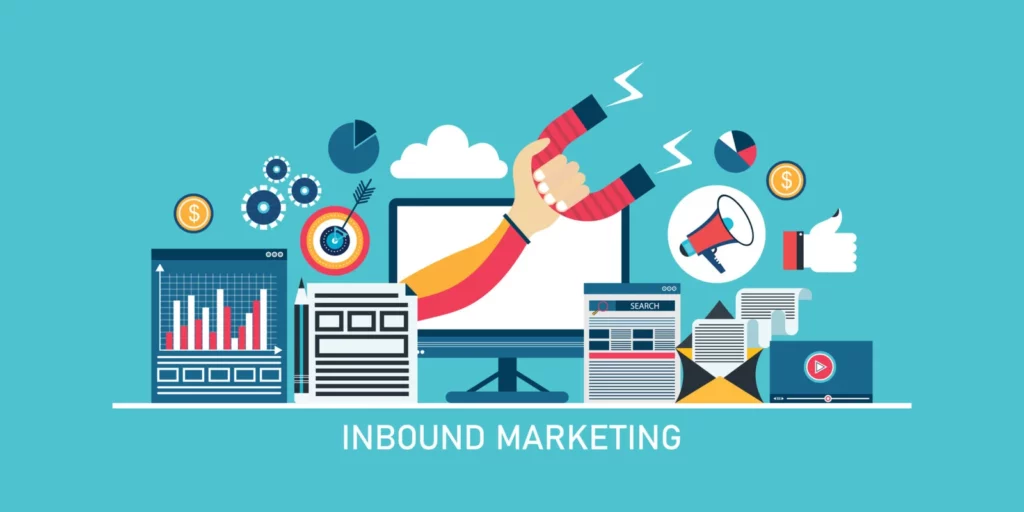In today’s digital world, it’s important to engage with people quickly and efficiently. Forget cold calling and annoying ads; the future is inbound marketing. It is being able to attract, engage, and delight customers. It is taking a stranger and making them a brand ambassador.
Choosing an inbound marketing option can feel overwhelming with so many tools and tactics on offer. But don’t worry, brave marketer, this guide will help you learn what you need to know and give you the confidence to tackle that landscape and obtain the leads you want.
Table of Contents
Best Inbound Marketing Tactics
With the right tactics, your inbound marketing options can shine. Here are some tactics you can use at each stage of the inbound marketing process:
Content Marketing
Create quality content your ideal customer wants. Blogs, infographics, whatever works for you—white papers, podcasts, webinars, etc. Make sure your content is optimized for keywords that are relevant, and make people aware of your content through your social media channels.
Identify your ideal customer persona, and create content that addresses their pain points, interests, and dreams. Use a mix of short/long-form blog posts, infographics, videos, podcasts, and fun interactive quizzes to keep your audience engaged.
Don’t simply publish and pray. Actively promote your content on social media and in industry forums, and leverage email marketing to expand your reach.
SEO
Invest in keyword research so that it pays off with every new customer who visits your website. We are regularly asked to review our client’s website performance and spend time on improving search engine performance. You need to optimize your website for search engines and as part of this exercise, it will help you identify if your website is mobile-friendly (it should be) and has a clear call to action.
There are a number of tools available to help with keyword research, such as Google Keyword Planner and Ahrefs. They will give you ideas for high-volume and low-competition keywords to target for your ideal audience.
You need to optimize your website titles, meta descriptions, headers, and image alt tags to lay them out around your target keywords. Additionally, you want to work on your website’s mobile-friendliness and page load speed and ensure that it is secure.
If you have a physical location, optimize your Google My Business.
Paid Advertisement
Make use of services such as Google Ads and Facebook Ads to accurately target new customers. Try different formats and see what works best and measure your success.
Know the demographics, interests, and online behaviors of your ideal customers and use this to precisely target your customers on sites like Google Ads. Don’t just use text ads, though; use image ads, video ads, and carousel ads to capture attention and maximize engagement with your advertisements.
We recommend you track your ad campaigns very tightly, analyze how they are performing, and then adjust your targeting, bids, and copy to achieve the highest return on your investment.
Also, make sure your landing pages are relevant to your ads and your landing pages are providing value propositions and compelling calls to action to convert your new clicks to leads.
Lead Capture
Give away a lot of valuable free content, such as ebooks or webinars, and get the customer’s email address in exchange. We are big advocates of targeted landing pages to convert website visitors into leads.
Provide valuable free resources such as ebooks, white papers, or recorded webinars in exchange for email addresses. Make sure the offers are related and relevant to your target audience and help them solve some problems. Include specific landing pages for each offer—include benefits for the opt-in and easy directions on how to opt-in.
Think about using exit intent popups to try to get someone’s email before they leave your site by using an emotional offer.

Email Marketing
Segment your leads to send emails that fit their needs and interests. Use automated nurture sequences to keep leads moving along through the funnel.
Do not blast the same emails out to everyone! Segment your leads in terms of interests, demographics, and purchase behavior, and send personalized messages that resonate with your leads.
Furthermore, your subject line is the first impression, so take advantage of it! Use concise, clear language, state benefits, and create intrigue to entice people to open your emails.
Every email needs to provide value to your audience. Whether that is through educational material, exclusive offers, or helpful hints, always have something valuable so that people feel engaged.
Social Media Engagement
Build authentic connections with your audience on social media channels. Respond to comments and messages promptly, and participate in conversations relevant to your business. Have contests and giveaways.
Delight and Convert
Landing Pages: Create landing pages tailored to the buyer’s journey, and A/B test for the best converting pages that have an obvious call to action!
Personalization
Personalize all content on your website, email, and marketing messages based on individual users’ wants and actions.
Customer Support
Go the extra mile to provide excellent customer service. Respond quickly to inquiries, resolve issues promptly, and go above and beyond to make your customers happy.
Don’t forget to experiment. Test different tools, tweak your strategies, and analyze your results. The beauty of inbound marketing is its flexibility—so embrace it and watch your marketing magic unfold.
Best Platforms for Inbound Marketing You Should Know in 2024
HubSpot
A powerhouse platform offering everything from blogging tools to social media management to analytics. Craft captivating content, optimize for search engines, and track your progress with ease.
Semrush
Dive into the keyword ocean with Semrush. Uncover search trends, analyze competitor strategies, and build a content calendar that attracts the right eyes.
Canva
Design like a pro, even without a Picasso complex. Canva’s intuitive interface helps you create stunning visuals, from infographics to social media graphics, that grab attention and keep viewers engaged.
Mailchimp
Email marketing is easy. Craft personalized email campaigns, automate workflows, and track engagement to nurture leads and turn them into loyal customers.
Drift
Chat with website visitors in real-time, answer their questions, and guide them through their buying journey. Personalize the experience and convert curious clicks into engaged conversations.
Zapier
Break down the silo walls! Zapier seamlessly connects your favorite tools, automating tasks and ensuring your marketing efforts flow smoothly from platform to platform.
Hotjar
See your website through your visitors’ eyes. Hotjar’s heatmaps and recordings reveal user behavior, allowing you to optimize your pages for maximum conversion rates.
Sprout Social
Manage all your social media channels in one place. Schedule posts, monitor conversations, and engage with your audience on Facebook, Twitter, and more.
NPSGen
Measure your customer satisfaction with Net Promoter Score (NPS) surveys. Identify promoters, address detractors, and continuously improve the customer experience.
From Clicks to Customers: Level Up Your Inbound Marketing
This is just a glimpse into the vast toolbox of inbound marketing solutions. Choose wisely based on your budget, needs, and audience. But beyond the tools, remember the core principles: create valuable content, engage authentically, and nurture relationships. With the right approach and the right solutions, your inbound marketing efforts will attract a wave of leads and empower you to turn them into lifelong fans.
Don’t forget to experiment. Test different tools, tweak your strategies, and analyze your results. The beauty of inbound marketing is its flexibility – so embrace it and watch your marketing magic unfold.
While flexibility is key, achieving your inbound marketing goals takes time and effort. Simplify your journey by partnering with EvolveDash, and let our experts craft a customized inbound marketing strategy to propel your success!
FAQs
- How long does it take to see results from inbound marketing?
Inbound marketing is a long-term strategy. While some tactics, like paid advertising, can bring immediate traffic, organic growth through content marketing and SEO can take several months. On average, businesses start seeing significant results within 6 to 12 months.
- What is the difference between inbound and outbound marketing?
Inbound marketing attracts customers through valuable content, SEO, and engagement, while outbound marketing involves direct outreach like cold calls, ads, and promotional emails. Inbound focuses on creating a pull effect, whereas outbound pushes messages to potential customers.
- How do I measure the success of my inbound marketing strategy?
Key metrics to track include website traffic, lead conversion rates, engagement levels (social media and email), customer acquisition costs, and return on investment (ROI). Tools like Google Analytics, HubSpot, and Semrush can help measure performance.
- Can small businesses benefit from inbound marketing?
Yes, inbound marketing is highly effective for small businesses because it allows them to attract and nurture customers without a large advertising budget. By consistently producing valuable content and optimizing for search engines, small businesses can compete with larger brands.
- How do I generate leads with inbound marketing?
Lead generation in inbound marketing relies on tactics like offering gated content (eBooks, webinars), optimizing landing pages, using email marketing, engaging on social media, and setting up automated lead nurturing sequences. The goal is to provide value and guide prospects through the sales funnel.



















